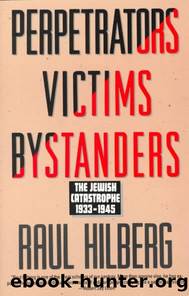Perpetrators Victims Bystanders: The Jewish Catastrophe 1933-1945 by Raul Hilberg

Author:Raul Hilberg [Hilberg, Raul]
Language: eng
Format: epub
Published: 0101-01-01T00:00:00+00:00
THE SURVIVORS
More than a million Jews who had lived under direct German control or in countries allied with Germany, and who had not fled to safety before or during the war, were still alive after May 1945.
The largest cluster in this remainder consisted of Jews who had not been engulfed in the final phase of the destruction process. Thus the Jewish communities of Old Romania and Bulgaria had been spared at the last moment by decisions of the governments in these countries. Also left were Jews living openly in cities where the Germans could no longer mobilize transport or police for deportations. Examples are Budapest, which had a ghetto during the winter of 19441945, and Paris, where quite a few Jewish families were still untouched in their apartments at the time of liberation. In addition, a sizable number of Jews were protected by their status, such as an effective foreign nationality or a mixed marriage.
A second major group had evaded death by hiding, resisting, or adopting a disguise. In Western Europe, many Jews found refuge in rooms, cellars, or attics of apartments or in monasteries or other institutions. In Yugoslavia, Greece, and Eastern Europe, some Jews were hiding in the mountains or woods, alone or with partisans. Almost everywhere, at least some Jews managed to obtain false papers to establish a false identity. In prisoner of war camps, where Soviet Jews were subject to shooting, some of the captives could pretend that they were non-Jews. Essentially these men concealed themselves, or were concealed, in the mass of other Soviet prisoners.
The third significant category in liberated territory or the conquered Reich were people who had been incarcerated to the very end. Among these individuals were the inhabitants of the Romanian-administered âcoloniesâ between the Dnestr and Bug rivers, the men in the Hungarian labor companies, the Jews in the remnant ghettos of Cernauti and Theresienstadt, those in labor camps, those in the concentration camps of Dachau, Buchenwald, Mauthausen, and Bergen-Belsen, those debarked from ships that had left the concentration camp Stutthof, and those abandoned in marches from camps and labor sites. Many of the people in the camps had been transferred from other locations, particularly Auschwitz. The camp Jews and the marchers were found in particularly poor physical condition.
No ironclad definition of the term Jewish survivor was fashioned during the postwar period. The concept has no distinct boundaries. Yet there is an unmistakable rank order among thejews who lived through the wartime Nazi years. In this hierarchy, the decisive criteria are exposure to risk and depth of suffering. Members of communities that were left intact and people who continued to live in their own homes are hardly considered survivors at all. At the other end of the scale, individuals who emerged from the woods or the camps are the survivors par excellence.
The idea that those who had reached bottom should be placed at the top is more than a matter of social restitution. They are elevated as possessors of a special kind of knowledge.
Download
This site does not store any files on its server. We only index and link to content provided by other sites. Please contact the content providers to delete copyright contents if any and email us, we'll remove relevant links or contents immediately.
| Africa | Americas |
| Arctic & Antarctica | Asia |
| Australia & Oceania | Europe |
| Middle East | Russia |
| United States | World |
| Ancient Civilizations | Military |
| Historical Study & Educational Resources |
The Third Pole by Mark Synnott(878)
Money for Nothing by Thomas Levenson(858)
The Economist (20210109) by calibre(854)
Christian Ethics by Wilkens Steve;(764)
Made in China by Anna Qu(762)
The Age of Louis XIV: The Story of Civilization by Will Durant(742)
Nonstate Warfare by Stephen Biddle(722)
100 Posters That Changed The World by Salter Colin T.;(716)
Reopening Muslim Minds by Mustafa Akyol(678)
The Irish Buddhist by Alicia Turner(676)
The Great Pyramid Void Enigma by Scott Creighton(675)
Routledge Handbook of Contemporary India by Knut A. Jacobsen(658)
The Shortest History of China by Linda Jaivin(658)
Ideology by Eagleton Terry;(657)
Culture by Terry Eagleton(646)
Sybille Bedford by Selina Hastings(617)
The Jews of Silence: A Personal Report on Soviet Jewry by Elie Wiesel(610)
Banaras: CITY OF LIGHT by Diana L. Eck(599)
Objects of Vision by Saab A. Joan;(599)
